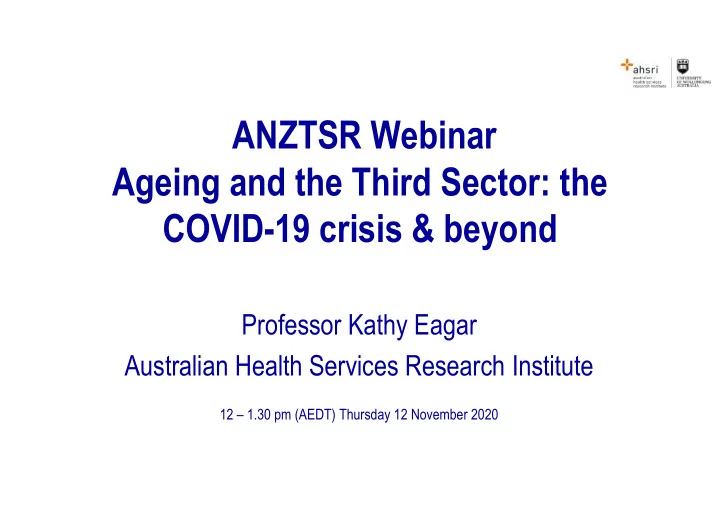

ANZTSR Webinar Ageing and the Third Sector: the COVID-19 crisis & beyond Professor Kathy Eagar Australian Health Services Research Institute 12 – 1.30 pm (AEDT) Thursday 12 November 2020
The starting point
When in a deep hole stop digging The aged care system needs fundamental reform Just throwing money at it won’t be one of the options on offer
Context: Aged Care Royal Commission Interim Report (Neglect) Aged Care in Australia: A Shocking Tale of Neglect “the aged care system fails to meet the needs of its older, vulnerable, citizens. It does not deliver uniformly safe and quality care, is unkind and uncaring towards older people and, in too many instances, it neglects them.” “The neglect that we have found in this Royal Commission, to date, is far from the best that can be done. Rather, it is a sad and shocking system that diminishes Australia as a nation.”
Government expenditure on aged care services, Aust Aust % 2018-19 ($ million) Assessment and information services $229.7 1.1% Home care and support services $5,902.1 29.4% Residential and flexible care services $13,831.9 68.8% Aged care quality $146.9 0.7% Total aged care expenditure $20,110.6 100.0%
Current aged care service mix ~840,000 low level home support (Commonwealth Home Support Program) – $2.7 billion, $2,800 per person ~150,000 higher level home support (Home Care Packages) – $2.6 billion, ~$20,000 per person. Range $8,000 (L1) to $50,000 (L4) ~240,000 residential aged care – $13.8 billion, ~$55,000 per person
Care needs The starting point for designing a better aged care system
Need for aged care People don’t need aged care because of their age People need aged care because they develop health conditions that result in functional loss, cognitive loss, behaviour issues &/or frailty – Social isolation & needs are the result, not the cause A social care system for older people isn’t enough Holistic care with five major domains: health, function, social, residential and palliative
Frailty Profile
My Top 10 wish list for the Royal Commission’s final report …
Reform 1 Dispel the myth that competition and the market are the best mechanisms to drive efficiency, quality and innovation and to respond to aged care consumer demand – This is evidence free policy – ‘Neglect’ is clear: aged care is not an industry; the ‘market’ is failing – Aged care needs to be built on relationships, not just transactions – The question is what mix should replace it
Reform 2 Dismantle the aged care “industry” along with the Commonwealth aged care program management structures
Reform 3 Introduce a national policy on the relationship between cost and price – Commonwealth payments to be sufficient to cover the cost of adequate and appropriate care – No profit care Providers to use care payments for care only , no profit – Profit from accommodation and hotel services is a separate issue
Reform 4 Reject the idea that there needs to be a trade off between clinically competent care and a social model of care Holistic care for older people includes meeting health, functional, social, residential and palliative care needs – Social model is essential but not enough – Respectful relationships & skilled clinical teams are key
Reform 5 Abolish the current national 'one size fits all' approach – Abolish the My Aged Care gateway – Challenge the illusion that what works in Melbourne and Sydney can work in the Kimberley and Central Australia
Reform 6 Move to regional aged care authorities (potentially Primary Health and Social Care Authorities) – Strengthen regional partnerships (health, social care, local government, community organisations) and community capacity to support and promote healthy ageing – Age friendly community services stream
Reform 7 Strengthen regional partnerships to support and develop responsive and sustainable aged care services – No wrong door – Assess for needs, strengths and preferences (and not just eligibility) – Local solutions, local ownership and community engagement
Reform 8 Substantially increase funding but with strings attached – No profit care policy care subsidies must be spent on care – A new AN-ACC funding model Regional assessment Residential care: – Adjustment payment, Base care tariffs and AN-ACC classification payment Develop AN-ACC classification branches for other aged care – Home care, respite, community rehabilitation, MPS’s, innovative care models (eg, payments for couples)
Reform 9 Introduce five star public reporting building on the US CMS model. – Casemix-adjusted staff hours (inputs) Three separate elements - nursing, allied health and total care staff – Inspections / accreditation (processes) – Consumer / carer experience of care (processes) – Casemix-adjusted quality indicators (outcomes)
Reform 10 Strengthen the evidence base to allow consumers to make informed choices about the care they receive. Three models of care for the future 1. Evidence informed practice 2. Innovation with evaluation 3. Innovation with informed consent: I understand that the care I am receiving is not evidence- based and is not being evaluated
Don’t get your hopes up… I expect to see very little of my Top 10 wish list in the Royal Commission’s final report
Recommend
More recommend